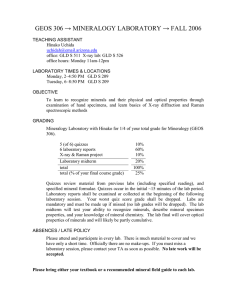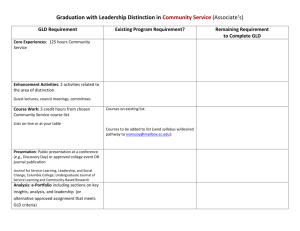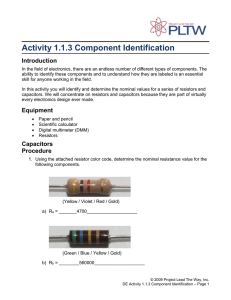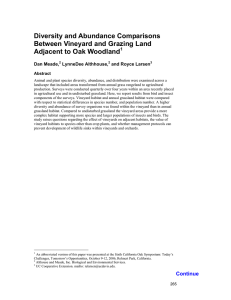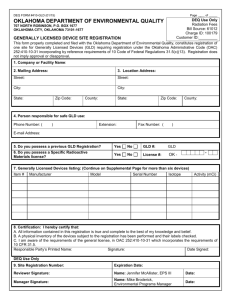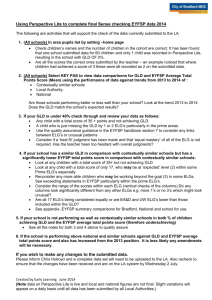Working Paper WP 2011-14 June 2011
advertisement
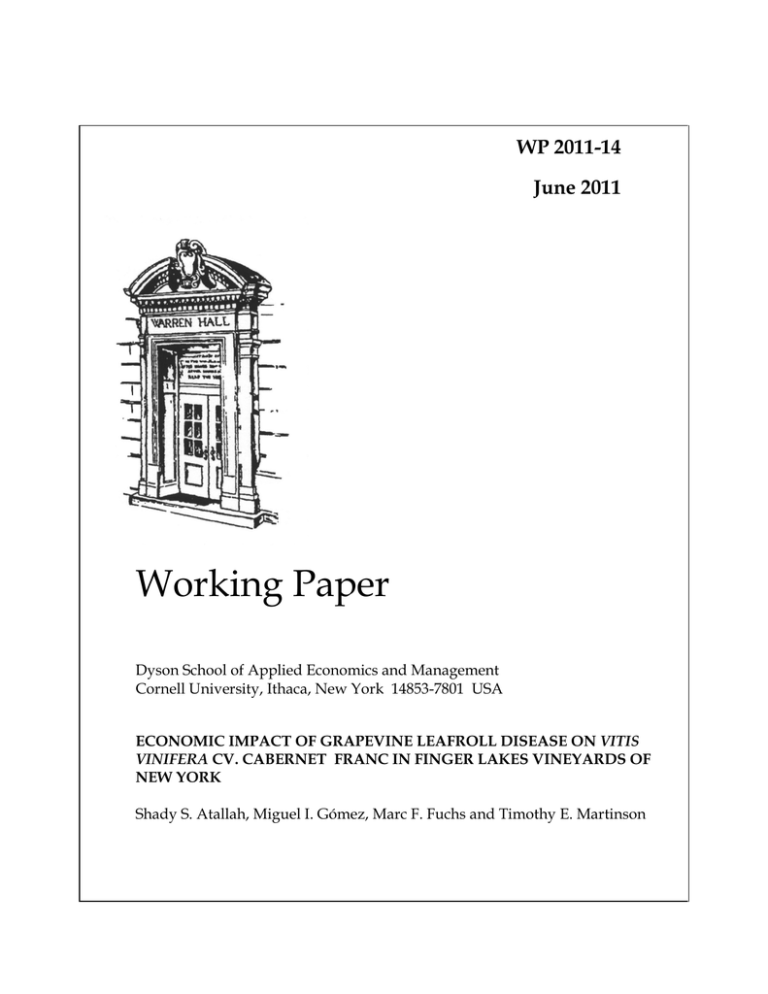
WP 2011-14 June 2011 Working Paper Dyson School of Applied Economics and Management Cornell University, Ithaca, New York 14853-7801 USA ECONOMIC IMPACT OF GRAPEVINE LEAFROLL DISEASE ON VITIS VINIFERA CV. CABERNET FRANC IN FINGER LAKES VINEYARDS OF NEW YORK Shady S. Atallah, Miguel I. Gómez, Marc F. Fuchs and Timothy E. Martinson It is the policy of Cornell University actively to support equality of educational and employment opportunity. No person shall be denied admission to any educational program or activity or be denied employment on the basis of any legally prohibited discrimination involving, but not limited to, such factors as race, color, creed, religion, national or ethnic origin, sex, age or handicap. The University is committed to the maintenance of affirmative action programs which will assure the continuation of such equality of opportunity. Economic Impact of Grapevine Leafroll Disease on Vitis vinifera cv. Cabernet franc in Finger Lakes Vineyards of New York Shady S. Atallah1*, Miguel I. Gómez1, Marc F. Fuchs2 and Timothy E. Martinson3 1 Charles H. Dyson School of Applied Economics and Management, Cornell University, Ithaca, NY 14852. 2 Department of Plant Pathology and Plant-Microbe Biology, Cornell University, New York State Agricultural Experiment Station, Geneva, NY 14456. 3 Department of Horticulture, New York State Agricultural Experiment Station, Geneva, NY 14456. * Corresponding author (email: sa589@cornell.edu) Acknowledgments: The authors thank the vineyard managers who participated in the survey. They also thank Gerald B. White whose initial work on the cost of production of Vitis vinifera in the Finger Lakes region of New York served as a basis for this study. This research was supported by a grant from the U.S. Department of Agriculture, Viticultural Consortium, New York Wine and Grape Foundation and Lake Erie Regional Grape Program (Grant Number 200934360-19879). This paper is a work in progress and comments are welcome. 1 Abstract: Leafroll disease is one of the most important virus diseases of grapevines worldwide. It reduces yields, delays fruit ripening, reduces soluble solids and increases titratable acidity in fruit juice. This study uses a Net Present Value (NPV) approach over a 25-year lifespan of a vineyard to examine the economic impact of grapevine leafroll disease (GLD) on Vitis vinifera cv. Cabernet franc in Finger Lakes vineyards of New York. It identifies optimal disease control options under several scenarios of disease prevalence, yield reduction, and fruit quality effects. The estimated economic impact of GLD ranges from about $25,000 (for a 30% yield reduction and no grape quality penalty) to $40,000 (for a 50% yield reduction and a 10% penalty for poor fruit quality) per hectare in the absence of any control measure. The per-hectare impact of GLD can be substantially reduced to $3,000-$23,000 through roguing if levels of disease prevalence are moderate (1% to 25%). With disease prevalence levels higher than 25%, replacing the entire vineyard is the optimal response, yielding economic losses of about $25,000 per hectare. Furthermore, the use of vines derived from certified, virus-tested stocks in replant sites is predicted to keep the costs associated with GLD infection to about $1,800 per hectare. Also, ‘no intervention’ appears to be the best management strategy when (1) infection levels are high (>25%), yield reduction is moderate (<30%) and no price penalty is enforced, or (2) GLD is transmitted through vectors after year 19. These findings are valuable to construct integrated decision matrices for vineyard managers to devise profit-maximizing disease control strategies and to create incentives for extended uses of clean, virus-tested planting material. Key words. Grapevine leafroll disease (GLD), Finger Lakes region of New York, net present value, roguing, vine replacement. 2 Grapevine leafroll disease (GLD) is one of the most widespread viral diseases in vineyards. It is reported in almost all grape and wine regions in the United States (Golino et al. 2008, Fuchs et al. 2009a) and worldwide (Walker et al. 2004, Freeborough and Burger 2006, Martelli and Boudon-Padieu 2006, Charles et al. 2009). GLD causes significant yield losses (up to 30-68%), delays fruit ripening, reduces soluble solids and increases titratable acidity in fruit juice (Goheen and Cook, 1959, Martelli and Boudon-Padieu 2006, Martinson et al. 2008). Several phloem-limited filamentous viruses, identified as grapevine leafroll-associated viruses (GLRaVs), were isolated and characterized from leafroll-infected grapevines (Martelli and Boudon-Padieu 2006, Ghanem-Sabanadzovic et al. 2010). All GLRaVs are readily transmitted by propagation and grafting, and some of them (GLRaV-1, GLRaV-3, GLRaV-5 and GLRaV-9) are also vectored by several species of mealybugs (Hemiptera: Pseudococcidae) and soft scale insects (Hemiptera: Coccidae) (Martelli and Boudon-Padieu 2006, Tsai et al. 2010). Varied measures are adopted by vineyard managers to manage GLD (Martinson et al. 2008, Walker et al. 2004). Most of them tend to tolerate the disease without controlling it in spite of its evident detrimental impact on yield and fruit quality. Some managers, in contrast, replace infected vines with healthy ones (i.e. roguing), while a few of them opt for replanting entire vineyards. Disease control decisions rely on a variety of factors but often do not take into account the impact on maturity and berry color at harvest. This may be explained by the fact that information about GLD impact on profits is scarce. Therefore, vineyard managers may not make profit-maximizing decisions regarding GLD control. Little is known about the economic effects of GLD, with a few notable examples. For instance, Walker et al. (2004) examined the impact of GLRaV-3 on gross margins in New Zealand vineyards using a model of virus spread under three infection scenarios (high, moderate and low) over six growing seasons. These authors estimated damages of approximately $21,200 3 per hectare ($8,600 per acre) by years 12, 15 and 17 for the high, moderate and low scenarios, respectively. Based on these results, the authors argued that replanting is justified in terms of increased profits by year 6, 8 and 11 for the same three scenarios, respectively. More recently, Nimmo-Bell (2006) employed a Net Present Value (NPV) approach to measure the economic costs of GLRaV-3 for Vitis vinifera cv. Sauvignon blanc and Merlot in New Zealand. The study compared the per-hectare NPV of infected and virus-free vineyard blocks under three scenarios of disease control: total vine removal in year 6, annual roguing of infected vines, and annual roguing of infected and neighboring vines. The authors concluded that early vine roguing is more cost-effective than total vineyard replacement in year 6. Vine roguing reduced the disease impact six-fold for Sauvignon blanc and seven-fold for Merlot when compared with the ‘no intervention’ scenario. In a study on the economic impact of GLRaV-3 on a V. vinifera Cabernet Sauvignon vineyard in the Stellenbosch region of South Africa, Freeborough and Burger (2006) showed that roguing was the only viable alternative to increase profits. In this study, we estimated the profitability impact of GLD in V. vinifera cv. Cabernet franc in Finger Lakes vineyards of New York. These estimates, in turn, were employed to recommend loss-minimizing management strategies for disease control. Specifically, the NPV approach was used to compare several GLD control strategies, including roguing, replacing the entire vineyard and doing nothing. These management strategies were used to (1) quantify disease damage under several scenarios and, (2) identify optimal management strategies based on infection level, extent of yield reduction, penalties imposed on fruit quality and vineyard age. 4 Materials and Methods Survey of vineyard managers. To construct economic analysis scenarios, a survey was conducted among ten vertically-integrated vineyard-winery operations in the Finger Lakes region of New York State during the period fall 2009 through spring 2010. The wineries selected had vineyards with a history of GLD infection based on Vitis vinifera cultivars showing typical leafroll symptoms or infected with GLRaV -1, GLRaV-2 and/or GLRaV-3, as indicated by ELISA and/or RT-PCR (Fuchs et al. 2009b). Respondents provided information about perceived ranges of GLD prevalence, magnitudes of yield reduction due to the disease, disease control measures adopted by vineyard managers, and penalties incurred due to poor fruit quality (see survey instrument in Appendix 1). Parameters used in construction of disease management scenarios. The survey responses were employed to specify the parameter ranges to be used in constructing the analysis scenarios as follows: GLD prevalence. Vineyard managers reported approximately 1, 5 and 40% levels of GLD infection. These values, as well as other prevalence values retrieved from the literature, were considered to identify threshold levels that determine switching from one management option to another. Vineyard managers recognized that the occurrence of GLD was mainly through infected vines at the time of planting. Spread of GLD by vectors. Managers did not recognize a pattern of virus spread via mealybug and soft scale insects, in spite of the documented presence of vectors species, including viruliferous individuals, in local vineyards (Fuchs et al. 2009b).The analysis employed a model of GLRaV-3 spread developed by Walker et al. (2004) to predict levels of virus infection in the presence of vectors. In that model, a GLD prevalence of 50% was predicted in 5 years 6, 8 and 11 for the three vineyards studied with low, medium and high GLD infection risk, respectively, and 90% in years 11, 12 and 15 (Walker et al. 2004). The data on GLD spread over time in the medium infection risk case was used to construct this study’s scenario of ‘no GLD control’ (Table 1, column N). [Table 1 here] Methods of GLD control. Vineyard managers practiced roguing (identifying, removing and replacing infected vines with vines derived from certified, virus-tested vines), replaced entire vineyards with virus-tested certified vines or did not respond to GLD. Yield reduction due to GLD infection. For the most part, vineyard managers did not attempt to measure yield reduction due to GLD. Therefore, the literature was reviewed and yield reductions of 30% and 50% were considered, given that 30-68% losses are commonly reported (Goheen and Cook 1959, Over de Linden and Chamberlain 1970, Martelli and Boudon-Padieu 2006, Martinson et al. 2008). Alteration of fruit quality due to GLD infection. The survey quantified quality reduction due to increases in titratable acidity and reductions in sugar content of fruit juice at harvest. It also identified contractual mechanisms used by buyers to penalize poor quality grapes. Vineyard managers did not systematically measure the impact of GLD on fruit juice chemistry. Instead, buyers inspected fruits and measured acidity and sugar levels. No vineyard manager reported rejection due to low quality grapes but one winery imposed a 10% price penalty when buying grapes that did not meet a sugar level requirement of 15-21 Brix. For that reason, two additional scenarios were added (NN30 and NN50) in order to identify any effect of the penalty incentive on the vineyard managers’ management decisions. Integration of survey data. All the answers provided by vineyard managers were integrated and used to estimate the economic impact of GLD and construct disease control 6 scenarios (no control, roguing, vineyard replacement) based on initial infection rates (0-60%), yield reduction (30% and 50%) and penalty for poor fruit quality (0 or 10%). The scenarios are described below and summarized in Table 2. [Table 2 here] Scenarios to assess GLD impact. Various scenarios were constructed, reflecting the cash flow of one hectare of V. vinifera cv. Cabernet franc over 25 years (the typical lifespan of a vineyard in the Finger Lakes). These scenarios differ by the biological and managerial parameters reported in the survey. Biological parameters include mode of disease transmission (e.g., through infected vines at time of planting for several levels of initial infection or, later on, through insect vectors) and various levels of yield impact. Management parameters, for their part, include disease control measures (e.g., no control, roguing at different infection levels, or entire vineyard replacement) and impact of the disease on price paid for the grapes due to quality losses (e.g. 10% penalty or no penalty). Additional scenarios were considered in order to analyze how vineyard age might impact GLD control decisions and to assess the value of disease prevention by planting vines procured from certified, virus-tested stocks. The following scenarios were considered, based on the survey responses from vineyard managers: Scenario 1: Baseline (B). The baseline scenario consists of a cash flow for one vineyard hectare over 25 years with no GLD prevalence. The baseline scenario was employed as a benchmark to estimate the economic impact of GLD under the scenarios described below. To this effect, the GLD impact was computed as the difference between the baseline NPV and the NPV of each alternative scenario. Scenario 2: No disease control (N). In this scenario GLD is introduced in year one (either through insect vectors or at planting through infected vines at a level of 1%), spreads following the logistic model suggested by Walker (2004), and the vineyard manager decides not to rogue or 7 replace the vineyard. Disease spread is summarized in Table 1 where column N lists the percentages of vines infected over time. This scenario was analyzed with a yield reduction of 30 and 50%, under either no penalty (NN 30 and NN 50) or a 10% penalty rate (N30 and N50) due to lower quality grapes. This yielded four scenarios that were used to estimate the economic impact of GLD when no control measures are implemented. Scenario 3: GLD prevention through establishing vineyards with planting material derived from certified, virus-tested stocks (C). This scenario simulates a situation where the vines used in a planting or replant site are derived from certified, virus-free stocks and cost 25% more than conventional vines, based on market prices. The NPV of this scenario is used to examine the benefits of a preventative approach to GLD by procuring clean vines at the time of planting in situations where vines of poor sanitary status are the only source of infection. Scenario 4: Roguing scenarios (T1-T60). These scenarios correspond to situations where GLD is introduced at planting at different levels ranging from 1 to 60% (T1-60) via diseased rootstocks. Infected vines start developing GLD symptoms in year 4 and are subsequently rogued as they become symptomatic. Asymptomatic, infected vines are not identified nor removed and the disease can be re-introduced through insect vectors. Therefore, disease prevalence does not drop immediately but rather decreases in a stepwise pattern, as initially asymptomatic vines develop symptoms over time and are rogued. It is assumed that the disease is never eradicated and is controlled at 1% at best. The stepwise decrease in disease prevalence is formulated for roguing scenarios with varied initial infection levels (T1, T5, T40 and T60) (Table 1). These parameters were used to identify the threshold infection level below which roguing is advisable and above which vineyard replacement is the appropriate response. In the roguing scenarios, it is assumed that there are no GLD-led reductions in yield or quality. 8 Scenario 5: Vineyard replacement (R). In this scenario, the vineyard manager decides to replant the entire vineyard at the onset of symptoms in year 4. This scenario reflects actions of surveyed managers who are willing to invest in replanting in order to avoid the uncertainty of coping with GLD and to minimize the probability of within-vineyard disease spread. The NPV of this scenario was used as a benchmark to identify infection level ranges that warrant vineyard replacement instead of roguing. Scenario 6: Late vector-mediated GLD infection (LV). In this scenario, GLD is introduced through insect vectors in years 12, 16 or 20. It identifies a possible vineyard age beyond which no intervention would be recommended given a vineyard lifespan of 25 years. Economic analysis. A NPV per hectare was calculated for each GLD control scenario over the economic lifetime of vineyards (25 years). GLD impacts were computed as the difference between the baseline NPV (i.e. no infection) and the NPV of the particular scenario considered. The NPV calculations are based on data (costs, revenues and financial assumptions) reported previously (White 2007), as described in Table 3; on survey data (disease prevalence, impact on yield and price paid for the grapes) collected; and findings from the literature. Fixed costs were omitted from the analysis because they are identical for the different scenarios. Optimal control measures were identified as those with the highest NPV. [Table 3 here] 9 Results Economic impact of GLD. The economic impact of GLD over the vineyard lifetime ranges from $25,407 per hectare ($10,282 per acre) (for a 30% yield reduction and no quality penalty) to $41,000 per hectare ($16,600 per acre) (for a 50% yield reduction and a 10% penalty for poor fruit quality) if no control measures are implemented (Table 4). [Table 4 here] Value of planting vines derived from certified, virus-tested stocks. Results indicate that paying a price premium of 25% for clean plant material reduces GLD-related losses to $1,829 per hectare ($740 per acre). This loss is substantially smaller than those following roguing, $3,207-$56,036 per hectare ($1,298-$22,677 per acre), and vineyard replacement, $24,654 per hectare ($9,977 per acre) (Table 5). It should be noted that this estimate does not take into account the possibility of a subsequent introduction of GLD through vectors; instead it focuses on the value of using certified vines to prevent the introduction of GLD at planting. [Table 5 here] Roguing or vineyard replacement. The NPVs for roguing at various levels of initial infection and vineyard replacement suggest the existence of a threshold level of disease prevalence beyond which the optimal GLD control is to replace the vineyard (Tables 5 and 6). Roguing yields higher NPVs than vineyard replacement for prevalence levels of 25% and below; and vineyard replacement yields the highest NPV for prevalence levels above 25%. The infection threshold is consistent with the survey responses. For example, a respondent that reported a 40% GLD prevalence decided to replace the vineyard, whereas others dealing with infection levels of 1 and 5% practiced roguing. Under optimal GLD control, the disease impact is reduced to a 10 range of $3,208 to $24,654 per hectare ($1,298 to $9,977 per acre) for scenarios of roguing at 1% GLD prevalence and vineyard replacement, respectively (Table 5). [Table 6 here] Late vector-mediated GLD infection. Roguing has a positive impact on NPV even when infection occurs at a later stage. Roguing reduces losses by $9,271 and $11,733 per hectare ($3,752 and $4,748 per acre) in years 12 and 16, respectively (Table 7). However, roguing increases losses in year 19 and after, suggesting the existence of a threshold vineyard age beyond which roguing is not optimal. This puts an upper bound on the age of the vineyard under which roguing remains economical; investing in planting new vines five years before the end of the lifecycle is not justified. [Table 7 here] No control. Roguing is optimal for disease management with a 50% yield reduction because the ‘no control’ scenario yields negative NPVs (Table 4, rows NN50 and N50). However, no control was the best response in certain instances. For example, for a 30% yield reduction and no penalty for poor fruit quality, the NPV equals the NPV of vineyard replacement with $7,690 per hectare ($3,112 per acre) (Table 4, column NN30) vs. $8,468 per hectare ($3,427 per acre) (Table 5). This result suggests that ‘no control’ is the best response when the level of infection is above 25% (i.e. for the range where vineyard replacement is optimal), yield reduction is less than 30% and there is no quality penalty. Changes in grape prices below ($1,700/t) and above ($1,900/t) the baseline price ($1,700/t) did not lead to changes in the recommendation of roguing when GLD prevalence is 25% and below and replacing the vineyard otherwise (Table 8). [Table 8 here] 11 Discussion The economic impact of GLD on V. vinifera cv. Cabernet franc in New York (approximately $25,000-$40,000 per hectare) is consistent with losses reported by Walker et al. (2004) (approximately $33,000-$50,000 per hectare by year 20 for three scenarios of infection risk) and Nimmo-Bell (2006) (approximately $47,000 per hectare) on V. vinifera cvs. Sauvignon blanc and Merlot in New Zealand. Sourcing clean, virus-tested vines reduces the economic impact of GLD to a value that is below any of the NPVs of disease control (Table 5). This finding suggests that vineyard managers should select virus-tested vines in order to maximize profits. Paying a premium of 25% on planting material derived from certified stocks is financially rewarding although it may not be attractive at a first glance. The estimated GLD impact is particularly alarming for the Finger Lakes wine industry given the high prevalence of GLD-causing viruses (Martinson et al., 2008, Fuchs et al. 2009a) and the documented presence of viruliferous insect vectors and their possible role in withinvineyard transmission (Fuchs 2008, Fuchs et al. 2009b). For example, sixty-nine percent of the Cabernet franc vineyards surveyed in 2006 in the Finger Lakes were GLD-affected (Martinson et al 2008). Applying this proportion to the Cabernet franc acreage in the region (approximately 55 ha or 136 acres) results in 38 ha (94 acres) of infected vineyards. Based on NPVs (Table 4), economic losses for that cultivar range from $1 to $1.5 million if the disease is not controlled. Evidence of high GLD prevalence and presence of GLRaV vectors in the region are relatively recent. This might explain why some vineyard managers have underestimated GLD-related losses. This study, along with the recent evidence of high GLD prevalence, provides disease impact information that vineyard managers need to take into account for implementing lossminimizing disease control measures. 12 Although this study sheds light on the economic impact of GLD, the results should be interpreted with caution. For example, disease spread patterns used in the study are from Walker et al. (2004) because no experimental data are available yet from the Finger Lakes. Given the low prevalence of mealybugs in the region (Fuchs et al. 2009a), the model could have overestimated the GLD impact under the no control scenario. Future research should survey GLD and vector prevalence over time to develop models of GLD spread that can be used to estimate impact with more accuracy. Earlier studies recommend controlling GLD through roguing of symptomatic vines and their replacement with healthy ones (Walker et al. 2004, Freeborough and Burger 2006, NimmoBell 2006). This study contributes to this literature by showing that roguing requires a large enough reduction in yield and/or enforcement of a price penalty on lower quality grapes to be economically justified. The 10% penalty rate reported in the survey may be too low and could underestimate the GLD impact on wine quality. For example, Walker et al. (2004) assumed that grapes from infected vines lost 75% of their value. This is considerably higher than the penalty reported in the Finger Lakes (10% according to the survey) and might suggest that wineries underestimate the impact of GLD on wine quality. Martinson et al. (2008) found that Brix was two degrees lower in grapes from GLD-affected vines than from healthy vines. Those grapes also had higher juice pH and lower titratable acidity. Further, sensory analysis studies are needed to link changes in Brix and acidity to changes in wine attributes and establish quality thresholds levels for the of sugar and acidity contents. Then, using wine hedonic price models, a quality penalty can be formulated in terms of ranges of sugar and acidity levels. Wineries would subsequently prevent a GLD-related decrease in wine quality either by rejecting grapes that do not meet those thresholds or by imposing a quality penalty on those grapes and using them to 13 produce bulk wines. This penalty can act as a price incentive for vineyard managers to control GLD and prevent a loss in the market value of their grapes. There are over thirty cultivars grown in the Finger Lakes. Although the analysis focuses on Cabernet franc, the results can be extended to other cultivars that are affected by GLD in the region such as Cabernet Sauvignon, Chardonnay, Lemberger, Merlot, Pinot noir and Riesling (Fuchs et al. 2009a). Cabernet franc was particularly important to analyze for two reasons. First, GLD symptoms are more visible in red than in white grape varieties (Martelli and BoudonPadieu 2006) and roguing is therefore more easily implemented. Second, GLD affects Cabernet franc more than other cultivars because it ripens later. This feature is crucial for cool-climate viticulture such as the one in the Finger Lakes because fruits from GLD-affected vines do not ripen before frost, are therefore harvested prematurely and jeopardize wine quality. When applying the results to situations where waiting for the grapes to ripen is an option, such as in warmer climates and/or with early cultivars, it might be appropriate to replace the quality penalty component of the GLD impact with a delayed harvest component and measure the economic losses associated with the delay, if any. GLD impact on other cultivars would also be different due to differences in market prices; higher prices imply greater values of GLD-related losses and vice-versa. Among the available disease prevention and control methods, vector control was not included in the scenarios of this study since the efficiency of insecticides at reducing GLD spread is still under study (Golino and Almeida 2008, Daane et al. 2008). 14 Conclusion The impact of GLD in Finger Lakes vineyards is estimated to range from $25,000 to $40,000 per hectare ($10,000 to 17,000 per acre) for scenarios of yield reduction and quality penalty over twenty-five years if left uncontrolled. Disease prevention through the use of certified, virustested vines at planting reduces the economic impact of GLD to $1,800 per hectare ($740 per acre). Roguing is optimal for vineyards with disease prevalence of 25% and below, as it reduces the impact to $3,000-23,000 per hectare ($1,300- 9,400 per acre) depending on initial GLD prevalence. When GLD prevalence is higher (>25%), replacement is the best response; it limits the impact to $25,000 per hectare ($10,000 per acre). Absence of disease control is economically justified when (1) infection levels are greater than 25%, yield reduction is less than 30% and no price penalty is enforced, or when (2) GLD is transmitted through vectors after year 19. This research provides vineyard managers with estimates of the economic impact of GLD on the profitability of their businesses. The results suggest that, in order to minimize potential losses due to GLD, managers ought to prevent infection by selecting certified, virus-tested vines for replant sites and by controlling the disease according to the decision matrix recommendations of this study. Future research should survey the prevalence of GLD and its vectors over time to develop models that capture the disease dynamics in the Finger Lakes. Translating our results to other grape-growing regions with GLD will require adjusting for differences in economic and epidemiological parameters that are unique to each region. However, independently of the region, we predict that roguing will remain the best control response up to a certain level of disease prevalence beyond which vineyard replacement will yield a higher net present value, and no disease control will be economically justified for certain parameter values. 15 Literature Cited Charles, J., K. Froud, R. van den Brink, and D. Allan. 2009. Mealybugs and the spread of Grapevine leafroll-associated virus 3 (GLRaV-3) in a New Zealand Vineyard. Australasian Plant Pathology 6:576-83. Daane., K.M., M.L. Cooper, S.V. Triapitsyn, VM.. Walton, G.Y. Yokota, D.Y. Haviland, W.J. Bentley, K.E. Godfrey, and L.R. Wunderlich. 2008. Vineyard managers and researchers seek sustainable solutions for mealybugs, a changing pest complex. California Agriculture 62:167-176. Accessed 4/2/2011 at http://californiaagriculture.ucanr.org/issue.cfm?volume=62&issue=4 Freeborough M-J and J. Burger. 2006. Leafroll: Economic implications. Wynboer. Accessed 4/2/2011 at http://www.wynboer.co.za/recentarticles/200812-leafroll.php3 Fuchs, M. 2008. Update on the Finger Lakes leafroll virus survey. Extended Abstract, Proc: 58th Annual Finger Lakes Grape Growers Conference, March 14-15, Waterloo, NY. Fuchs, M., Loeb, G.M. Martinson, T.E., and Hoch, H.C. 2009a. Diversity of ampeloviruses in mealybug and soft scale vectors and in grapevine hosts from leafroll-affected vineyards. Phytopathology 99:1177-1184. Fuchs, M., Martinson, T.E., Loeb, G.M., and Hoch, H.C. 2009b. Survey for the three major leafroll disease-associated viruses in Finger Lakes vineyards in New York. Plant Disease 93:395-401. Ghanem-Sabanadzovic, A., N., Sabanadzovic, S., Uyemoto, J.K., Golino, D., and Rowhani, A. 2010. A putative new ampelovirus associated with grapevine leafroll disease. Archives of Virology 155:1871–1876. 16 Golino D.A., Weber E., Sim S., and A. Rowhani. 2008. Leafroll disease is spreading rapidly in a Napa Valley vineyard. California Agriculture 62:156. Accessed 4/2/2011 at http://www.napagrowers.org/PDF/LEAFROLL_CAv061n04p156.pdf Golino D.A., and R. Almeida. 2008. Sidebar: Studies needed of vectors spreading leafroll disease in California vineyards. California Agriculture 62:174. Accessed 4/2/2011 at http://californiaagriculture.ucanr.org/issue.cfm?volume=62&issue=4 Goheen, A. C., and J. A. Cook. 1959. Leafroll (red-leaf or rougeau) and its effects on vine growth, fruit quality, and yields. Am. J. Enol. Vitic. 10:4:173-181 Martelli, G. P. and Boudon-Padieu, E. 2006. Directory of infectious diseases of grapevines. International Centre for Advanced Mediterranean Agronomic Studies. Options Méditerranéennes Ser. B, Studies and Research 55:59-75. Martinson, T., Fuchs, M., Loeb, G., Hoch, H. 2008. Grapevine leafroll: an increasing problem in the Finger Lakes, the US and the World. Finger Lakes Vineyard Notes 6:6-11. Nimmo-Bell. 2006. The economic effects and financial impact of GLRaV3. A Nimmo-Bell Publication, March 2006: 18pp. Over de Linden AJ, Chamberlain EE. 1970. Effect of grapevine leafroll virus on vine growth and fruit yield and quality. New Zealand Journal of Agricultural Research 13: 689-698. Tsai, C.W., Rowhani, A., Golino, D.A., Daane, K.M., Almeida, R.P.P. 2010. Mealybug transmission of grapevine leafroll viruses: an analysis of virus-vector specificity. Phytopathology 100: 830-834. Walker, J.T.S. Charles, J.G. Froud, K.J., Connolly, P. 2004. Leafroll virus in vineyards: modeling the spread and economic impact. Report to New Zealand Winegrowers Limited: 19 pp. 17 White, G. 2007. Cost of establishment and production of vinifera grapes in the Finger Lakes region of New York. Cornell University Publication E.B. 18 Table 1 Description of disease parameters: prevalence and grape yield over time Vines infected (%) Yield Healthy Years a N T1 b T5 T40 T60 tons/ acre t/ ha 50% reductionc 30% reductionc t/ha tons/ acre t/ha tons/ acre 0 0 -d 0 0 0 0 0 0 1 1 0 0 0 0 0 0 2 2 0 0 0 0 0 0 3 8 2.2 1.0 2.15 0.96 2.17 0.97 4 12 1 5 40 60 7.4 3.3 6.94 3.10 7.12 3.18 5 22 1 3 20 40 7.4 3.3 6.58 2.94 6.89 3.08 6 28 1 1 10 20 7.4 3.3 6.36 2.84 6.76 3.02 7 36 1 1 5 10 7.4 3.3 6.07 2.71 6.58 2.94 8 48 1 1 3 5 7.4 3.3 5.62 2.51 6.31 2.82 9 60 1 1 1 3 7.4 3.3 5.17 2.31 6.07 2.71 10 70 1 1 1 1 7.4 3.3 4.81 2.15 5.84 2.61 11 80 1 1 1 1 7.4 3.3 4.43 1.98 5.62 2.51 12 88 1 1 1 1 7.4 3.3 4.14 1.85 5.44 2.43 13 92 1 1 1 1 7.4 3.3 3.98 1.78 5.35 2.39 14 95 1 1 1 1 7.4 3.3 3.87 1.73 5.28 2.36 15-19 98 1 1 1 1 7.4 3.3 3.76 1.68 5.21 2.33 20-25 10 1 1 1 1 7.4 3.3 3.69 1.65 5.17 2.31 a N: GLD infection levels derived from the model of Walker et al. (2004) for the no control scenario b T1, T5, T40 and T60: roguing scenarios at 1, 5, 40 and 60% initial infection levels. GLD prevalence under roguing was assumed to decrease following a stepwise pattern. c Yield was calculated as %infected vines*yield of infected vines + %healthy vines*yield of healthy vines where yield reduction due to GLD is assumed to be 50% and 30% d It is assumed that GLD is due to rootstock infection; therefore, 0-3 years old vines do not develop GLD symptoms. 19 Table 2 Description of disease control scenarios Initial Yield Quality infection reduction (%) penalty level (%) (%) 0 30 50 0 10 0 x x Scenarios Baseline (B) GLD introduction a none vines vectors x No disease control NN50 NN30 N50 N30 1 1 1 1 x x x 1-60 x Replacement (R) any n/a 0 Roguing, late vectormediated infection (TLV) 0 x x x Roguing (T1-T60) No disease control, late vector-mediated infection (NLV) x x x n/a n/a n/a x x x x x x x n/a x x x x x x x x x x Planting certified, 0 x x x virus-tested vines (C) a GLD transmission within vineyards is not included here because it is assumed to be vectormediated in all scenarios b Not applicable NN50: No control, no penalty, 50% yield reduction; NN30: No control, no penalty, 30% yield reduction; N50: No control, 10% penalty, 50% yield reduction; and N30: No control, 10% penalty, 30% yield reduction 20 Table 3 Production, cost, revenue and financial assumptions Production Cost Revenue Financial Item Value and unit Row spacing 2.7 m (9 ft) Vine spacing 1.8 m (6 ft) Planting density 1,994 vines/ha (807 vines/acre) Vine replacement without GLD 2% Skilled labor wage $16.6/hr Unskilled labor wage $11.60/hr Gasoline $0.76/L ($2.90/gallon) Diesel $0.87/L ($3.32/gallon) Vines $3.25/vine Price $1,874/t ($1,700/ton) Yield (years 4 and above) 7.4 t/ha (3.3 tons/acre) Discount rate 7.37% Project life cycle 25 years Source: White (2007) 21 Table 4 NPV of no GLD control scenarios under different yield reduction (30 and 50%) and quality penalty (0 and 10%) conditions GLD economic impact* Scenarios NPV $/ha $/acre $/ha $/acre No control, no penalty, 30% yield reduction (NN30)a $7, 690 $3,112 $25,407 $10,282 No control, 10% penalty, 30% yield reduction (N30) $6,786 $2,746 $26,334 $10,657 No control, no penalty, 50% yield reduction (NN50) ($7119)b ($2,881) $40,241 $16,285 No control, 10% penalty, 50% yield reduction (N50) ($7,900) ($3,197) $41,019 $16,600 $8,468 $3,427 $24,651 $9,977 Replacing the vineyard at onset of symptoms in year 4 (R) a See description of scenarios in Table 1 Number in parenthesis represent losses b 22 Table 5 Economic impact of GLD under vine roguing, vineyard replacement, and planting virus-tested vines a Disease control scenarios GLD economic impactb NPV $/ha $/acre $/ha $/acre Baseline scenario (B) $33,122 $13,404 $0 $0 Establishing vineyard with certified, virus-tested vines (C) $31,291 $12,663 $1,829 $740 1 $29,915 $12,106 $3,207 $1,298 5 $26,084 $10,556 $7,038 $2,848 10 $22,351 $9,045 $10,771 $4,359 20 $14,275 $5,777 $18,847 $7,627 25 $9,815 $3,972 $23,307 $9,432 26 $8,115 $3,284 $25,007 $10,120 30 $5,261 $2,129 $27,861 $11,275 40 $2,000 ($809)c $35,121 $14,213 50 ($9,244) ($3,741) $42,366 $17,145 60 ($22,914) ($9,273) $56,036 $22,677 $8,468 $3,427 $24,654 $9,977 Roguing scenarios (T1-60) Vineyard replacement (R) a See Table 1 for scenario description The GLD impact is computed as the difference between the NPV of roguing and the baseline NPV c Number in parenthesis represent losses b 23 Table 6 GLD control decision matrix based on yield reduction, GLD prevalence and a quality penalty 30% yield reduction 10% penalty No penalty ≤ 25% infection roguea rogue > 25% infection replace vineyard indifferent ≤ 25% infection rogue rogue > 25% infection replace vineyard do not control ≤ 25% infection rogue rogue > 25% infection replace vineyard replace vineyard Less than 30% yield reduction 50% yield reduction a Recommendations in decision matrix are based on results from Tables 4 and 5. 24 Table 7 NPV of scenarios depicting late vector-mediated transmission occurring in years 12, 16 or 20 with (TLV)a and without roguing (NLV). NPV Impact of roguingb Late vector-mediated infection scenarios $/ha $/acre Year 12, no roguing (NLV 12) $23,502 c $9,511 Year 12, roguing (TLV12) $32,774 $13,263 Year 16, no roguing (NLV 16) $18,286 $7,400 Year 16, roguing (TLV16) $30,018 $12,148 Year 20, no roguing (NLV 20) $31,118 $12,593 Year 20, roguing (TLV20) $30,270 $12,250 a $/ha $/acre $9,272 $3,752 $11,733 $4,748 ($848)d ($343) See Table 1 for scenario description The impact of roguing is computed as the difference between the NPV of roguing and the NPV of ‘no roguing’ c The NPVs are computed using infection levels from Table 2, column N d Number in parenthesis represent losses b 25 Table 8 Sensitivity analysis with respect to price: the recommendation of replacing the vineyard beyond 25% GLD prevalence is unchanged NPV NPV NPV Disease control p=$1,764/t ($1,600/ton) $/ha $/acre p=$1874/t ($1,700/ton) $/ha $/acre p=$1984.5/t ($1,800/ton) $/ha $/acre Roguing at 20% GLD (T20) $7,816 $3,163 $14,275 $5,777 $20,732 $8,390 Roguing at 25% GLD (T25) $3,506 $1,419 $9,815 $3,972 $16,124 $6,525 Roguing at 26% GLD (T26) $1,307 $529 $8,115 $3,284 $13,779 $5,576 ($329) $5,261 $2,129 $11,332 $4,586 $987 $8,468 $3,427 $14,498 $5,867 Roguing at 30% GLD (T30) ($813)a Replacing vineyard (R) $2,439 a Number in parenthesis represent losses p = price 26 Appendix 1. Survey instrument 1. PREVALENCE: What percentage of your vineyard is affected by leafroll? (Highlight one) a. 0 b. 0-10 c. 10-25 d. 25-50 e. 50 or more f. I don’t know 2. VARIETIES: What grape varieties are affected by leafroll? 3. SYMPTOMS OF LEAFROLL VIRUS ON CROP: In the following section, please mention whether you noticed a change in vine yield, sugars and/or acidity associated with the leafroll virus infection. If changed occurred, please indicate the degree of change, if measured or estimated (highlight answer). Yield decreased by (%): a. b. c. d. e. 0 (no decrease) 0-10 10-25 25-50 50 or more Sugars decreased by (Brix): a. b. c. d. e. f. 0 (no decrease) 0-1 1-2 2-3 3-4 I don’t know Acidity increased by (g/L): a. b. c. d. e. f. 0 (no decrease) 0-0.5 0.5-1 1-2 2 or more I don’t know 4. CHANGES IN AGRICULTURAL PRACTICES IN RESPONSE TO LEAFROLL PREVALENCE: Have you replanted your vineyard in response to leafroll infection? Yes No (highlight one). If not, have you changed any of the following practices as a response to your vineyard leafroll infection? (Tick the appropriate cell). If yes, please mention how many units (of labor or equipment) you had to utilize on each activity as a result of leafroll infection. yes no If yes, how many units (vines replanted, quantity fertilizer/pesticide, etc) Vine replacement Leaf removal Fertilization Pesticide Other: 27 5. CONTRACTS WITH VINEYARDS: Do you buy/sell grapes from vineyards other than your own? Yes No (highlight one) If yes, do you have contracts with those vineyards? Yes No (highlight one) If yes, does the contract refer to quality standards related to the sugars and/or the acidity of the grapes? Yes No (highlight one) If yes, what are those standards? a. Sugars: b. Acidity: How do you penalize (get penalized for) lower standards? a. No penalty for lower standards b. Batch is refused c. There is a penalty of: 28 OTHER A.E.M. WORKING PAPERS Fee WP No Title (if applicable) Author(s) 2011-13 Organization, Poverty and Women: Andhra Pradesh in Global Perspective Dev., S., Kanbur, R. and G. Alivelu 2011-12 How have agricultural policies influenced caloric consumption in the United States? Rickard, B., Okrent, A. and J. Alston 2011-11 Revealing an Equitable Income Allocation among Dairy Farm Partnerships Dressler, J. and L. Tauer 2011-10 Implications of Agglomeration Economics and Market Access for Firm Growth in Food Manufacturing Schmit, T. and J. Hall 2011-09 Integration of Stochastic Power Generation, Geographical Averaging and Load Response Lamadrid, A., Mount, T. and R. Thomas 2011-08 Poor Countries or Poor People? Development Assistance and the New Geography of Global Poverty Kanbur, R. and A. Sumner 2011-07 The Economics of Africa Aryeetey, E., Devarajan, S., Kanbur, R. and L. Kasekende 2011-06 Avoiding Informality Traps Kanbur, R. 2011-05 The Determinants of Minimum Wage Violation in South Africa Bhorat, H., Kanbur, R. and N. Mayet 2011-04 Minimum Wage Violation in South Africa Bhorat, H., Kanbur, R. and N. Mayet 2011-03 A Note on Measuring the Depth of Minimum Wage Violation Bhorat, H., Kanbur, R. and N. Mayet 2011-02 Latin American Urban Development Into the 21st Century: Towards a Renewed Perspective on the City Rodgers, D., Beall, J. and R. Kanbur 2011-01 The Hidden System Costs of Wind Generation in a Deregulated Electricity Market Mount, T., Maneevitjit, S., Lamadrid, A., Zimmerman, R. and R. Thomas 2010-22 The Implications of Alternative Biofuel Policies on Carbon Leakage Drabik, D., de Gorter, H. and D. Just 2010-21 How important are sanitary and phytosanitary barriers in international markets for fresh fruit? Rickard, B. and L. Lei Paper copies are being replaced by electronic Portable Document Files (PDFs). To request PDFs of AEM publications, write to (be sure to include your e-mail address): Publications, Department of Applied Economics and Management, Warren Hall, Cornell University, Ithaca, NY 14853-7801. If a fee is indicated, please include a check or money order made payable to Cornell University for the amount of your purchase. Visit our Web site (http://aem.cornell.edu/research/wp.htm) for a more complete list of recent bulletins.
